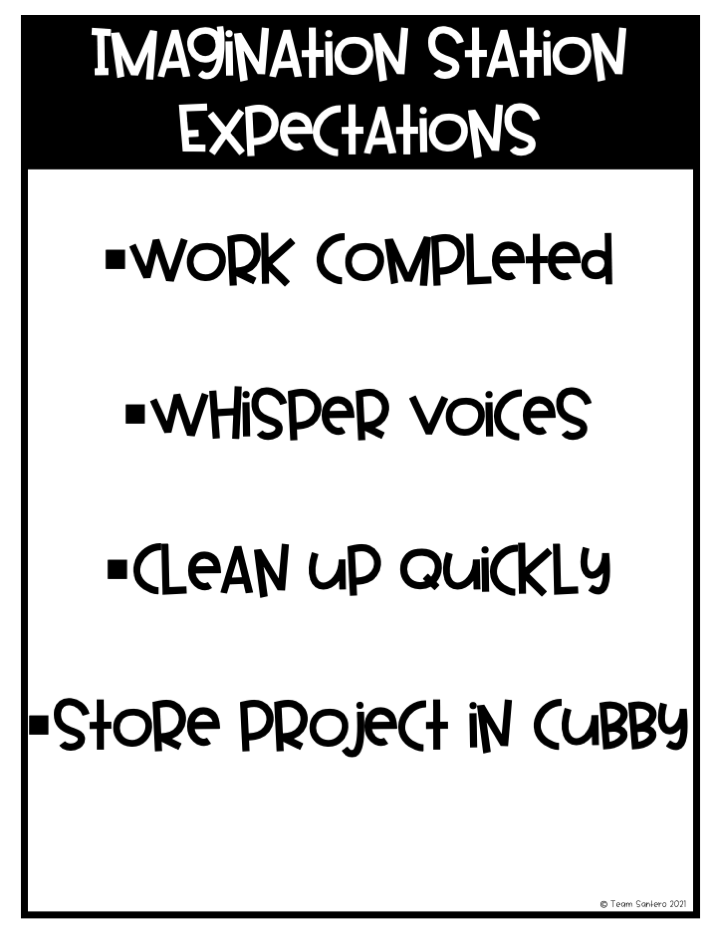
Engaging students in the classroom can be a challenge, especially when some students finish their work quickly. However, it is important to provide opportunities for creativity and exploration for all students. To address this, I have created Imagination Station Activities to guide and support fast finishers. These activities are similar to Genius Hour Projects but with more structure. Each month, I provide my students with six Imagination Ideas to choose from. This allows them to continue learning and exploring new topics while also fostering their creativity.

5 Steps to Imagination Station
Imagine- Give the students a topic(s) and or prompt(s) for them to focus on
(for example, January – build a snowman or a snow fort, February – create a valentine’s box or promote an act of kindness)
Brainstorm- Students will brainstorm ideas on what their project will look like and what they will need to create it. I guide this process with some graphic organizers
Design: Next, students will create a sketch of their design with labels and explanations.
Create– The most fun part, students will build their prototype using items found in the classroom. Be ready with items like paper, glue, tape, cardboard, and other random items for creation!
Present: Finally, students will create a presentation to explain or go into more depth with their Imagination project.

I’m Done Now What…
I created a poster that hangs on my wall that says, ‘I’m Done Now What” to help reduce the number of times my students ask this very question. It simply lists the activities they can do when done with their assignments. I list the activities they can choose from and point at it a few times a day. These days they are choosing the Imagination Station once they are done and I love it. Since it is so popular, being organized is key to success!
I am huge about organization and keeping my classroom neat. When I first started Imagination Station for my fast finishers, I knew I would have to create a process to help keep things organized. Here’s what I did!
Imagination Station Process and Procedures
Step 1: I found a crate box that matched my classroom and labeled it Imagination Station.
Step 2: I printed off my Imagination Station Activities and put them in their own file folder in the crate.
Step 3: I found a small plastic box that fits in the crate to hold some needed supplies.
Step 4: I gathered construction paper and random supplies from our workroom and cupboards. Some items in my box include construction paper, popsicle sticks, tape, glue, pom poms, googly eyes, straws, gallon-sized baggies, and various random things.
Step 5: I read each of the imagination ideas off to my students and remind them of the rules for Imagination Station.
Step 6: I reminded students that their project must fit in their cubby and should be placed in a gallon-sized ziplock baggie for safekeeping. I also have them store materials in their ziplock baggie while working on their project.
Fast Finisher Expectations
In my classroom, I have certain expectations for students who finish their work quickly. They understand that they need to complete their assigned tasks before moving on to the Imagination Station. It’s important for them to prioritize quality over speed and not rush through their work. While working on creative projects at the Imagination Station, they are expected to whisper so as not to disturb their classmates who are still working. When it’s time to clean up, they are required to do so promptly when I signal with our doorbell. It may take some time for this routine to become smooth and seamless, but once it does, it feels like magic.

Try an Imagination in your classroom
Introduce an Imagination Station in your classroom and watch your students’ creativity soar! This center activity provides an opportunity for each student to engage in imaginative and hands-on projects at least once a month. Not only will your students love showcasing their work to the class, but they will also be actively learning and developing important skills. By incorporating an Imagination Station, you can unlock your students’ creativity, foster autonomy, and create a dynamic learning environment. Give it a try and see the amazing results!
